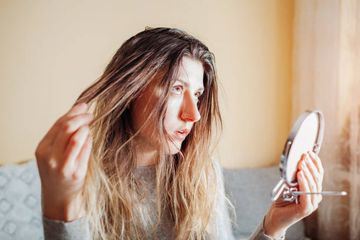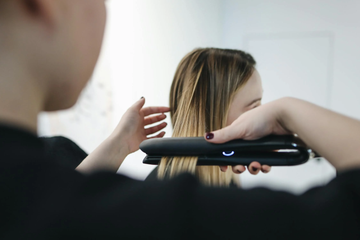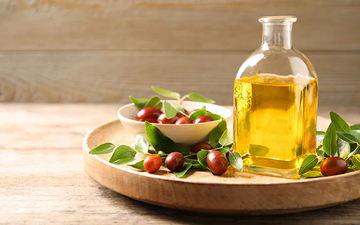Grease-proof your strands with these easy fixes
We’ve all been there: second-day hair that’s more slick than sleek, leaving you in a constant battle with dry shampoo or a too-frequent shampoo habit. Overwashing? It’s making things worse. The struggle is real, and oily hair can feel like it’s calling out for attention—just not the good kind.
Rushing out the door or caught in a midday grease spiral? We’ve got you covered. From small changes to your routine to genius styling hacks and product swaps, these tips will keep your hair looking fresh for longer. Desperate to know how to make hair less oily? Let’s get into it.
What makes hair oily?
Oily hair isn’t just about bad luck. It’s a combination of factors that can work together to sabotage your fresh-wash vibes. The main culprit? Your scalp’s sebaceous glands. These tiny oil factories produce sebum, a natural oil designed to keep your hair healthy and hydrated. But when they go into overdrive, it’s grease central.
Genetics plays a big role. Some scalps naturally produce more oil than others. Hormonal changes, like those during puberty or your monthly cycle, can also crank up oil production. Then there’s the impact of environmental factors like humidity, which makes your scalp sweat more, or pollution, which clings to that extra oil, making hair appear dirtier.
Overwashing is another sneaky contributor. Stripping your scalp of oils can cause it to produce even more in a bid to compensate. Lastly, product build-up from heavy conditioners or silicone-packed styling products can weigh hair down, leaving it limp and greasy.
How to make hair look less oily (10 hacks)
If greasy strands are ruining your hair goals, it’s time to fight back with smart, practical tricks that you’ll wish you knew sooner!
Hack #1: Use dry shampoo strategically
Dry shampoo is every oily-haired person’s secret weapon, but there’s a method to the madness. Apply it before your hair gets greasy—think the night before or first thing in the morning. This preemptive strike absorbs oil as it appears, keeping your scalp fresh and roots lifted.
For even distribution, spray at the roots section by section, hold it 6–8 inches away, and let it sit for a minute before massaging or brushing it through. Pro tip: Skip overusing it—it’s meant to extend washes, not replace them entirely, or you risk buildup that could make things worse.
Hack #2: Incorporate hair cycling into your routine
Hair cycling is the balanced approach oily hair craves. Rotate products to address your hair’s changing needs, alternating between clarifying, hydrating, and lightweight shampoos. Start your week with a clarifying shampoo to deep-clean buildup, then switch to a nourishing formula mid-week for hydration without heaviness. Save your sulfate-free or balancing shampoo for regular maintenance.
This method keeps your scalp happy, prevents over-stripping, and ensures you’re tackling oiliness without compromising your hair’s overall health. Hair cycling also reduces dependency on heavy-duty cleansers—because sometimes, less is more.
Hack #3: Switch to a boar bristle brush
A boar bristle brush is a game-changer for balancing oils. Unlike regular brushes, it distributes your scalp’s natural oils from root to tip, giving your strands a healthy shine while keeping excess grease at bay. Use it on dry hair, starting at the roots and brushing in sections to smooth oils down.
This tool is especially great for extending the time between washes, as it prevents buildup at your scalp and hydrates your ends naturally. Invest in a high-quality boar bristle brush to avoid tugging or breakage—it’s worth it for a sleeker, more manageable mane.
Hack #4: Rinse your hair with apple cider vinegar
Apple cider vinegar is the ultimate DIY clarifier for oily hair. Its acidity helps balance your scalp’s pH, reducing excess oil production while removing buildup from products and hard water. Mix one part vinegar with two parts water, pour it over your hair after shampooing, and let it sit for a couple of minutes before rinsing thoroughly.
The result? Cleaner roots and shinier strands. Just don’t overdo it—stick to once a week to avoid drying out your hair. Bonus: It also helps tame frizz and enhance shine, making it a multitasking marvel in your hair care arsenal.
Hack #5: Limit how often you touch your hair
Hands off! Constantly touching or running your fingers through your hair transfers oils from your hands to your strands, making it greasy faster. It’s a habit many don’t realize is sabotaging their efforts to stay fresh between washes. Try tying your hair back loosely if you can’t resist the urge to fuss with it, or focus on a textured style that discourages touch.
Pro tip: Clean your phone screen regularly—it’s another sneaky culprit for transferring oil to your hair, especially around the temples and hairline. Small changes like these can extend the life of your blowout or style.
Hack #6: Sleep on a silk pillowcase
Beyond being a beauty luxury—a silk pillowcase is a must for oily hair. Unlike cotton, silk doesn’t absorb moisture or oils, meaning your hair stays fresher overnight. It also reduces friction, minimizing breakage and frizz as you toss and turn.
Pair this with tying your hair in a loose braid or bun to prevent oil buildup at the roots while you sleep. Plus, silk is gentler on the skin, so it’s a win for your face too. Upgrade your pillowcase for less morning grease and smoother, more manageable hair that doesn’t require a midday refresh.
Hack #7: Schedule regular clarifying treatments
Sometimes your regular shampoo just can’t cut through the buildup of oils, products, and pollutants weighing down your hair. Enter clarifying treatments—your deep-cleaning reset button. These specialized shampoos and treatments target stubborn residue, leaving your scalp squeaky clean and refreshed.
Aim for a clarifying session every two weeks or once a month, depending on how much product you use. Just remember to follow up with a nourishing conditioner to restore moisture balance. The main benefit? Regular clarifying keeps your roots looking fresher for longer and helps your go-to styling products perform even better.
Hack #8: Switch to a sulfate-free shampoo
If you’re fighting greasy roots, a sulfate-free shampoo is the trick up your sleeve. Unlike traditional shampoos, sulfate-free formulas cleanse without over-stripping your scalp’s natural oils—because here’s the catch: Over-cleansing can actually make your scalp overproduce oil as it tries to compensate.
Look for lightweight, oil-balancing ingredients like tea tree or peppermint oil to refresh your scalp while maintaining hydration. Even better, sulfate-free shampoos are also gentler on color-treated and textured hair, making them a win for nearly everyone. Use regularly for clean, healthy hair without the grease rebound.
Hack #9: Style hair with volume-enhancing techniques
Flat, limp hair tends to look greasier faster, so giving your roots a little lift can work wonders. Start with a volumizing mousse or root spray, then blow-dry upside down for instant height. You can also tease the crown or use Velcro rollers for a polished finish.
Opt for hairstyles that add dimension, like loose waves using the TYME Iron Pro or a messy ponytail. The extra texture helps disguise any oiliness while extending the life of your style. Pro tip: A touch of dry shampoo before styling doubles as a root boost and keeps oil at bay.
Hack #10: Take care when shampooing
It might sound counterintuitive, but being too aggressive while shampooing can exacerbate oiliness. Scrubbing your scalp too hard stimulates oil glands, encouraging them to produce even more sebum. Instead, use gentle, circular motions with your fingertips (not nails) to cleanse your scalp effectively. Pair this technique with lukewarm water—hot water can strip oils and send your sebaceous glands into overdrive.
Think of it as a scalp massage, not a deep scrub. This gentle approach ensures clean roots without triggering excessive oil production, keeping your hair fresher for longer.
How to care for oily hair
Creating the perfect oily hair routine requires balancing effective cleansing with scalp care to prevent the overproduction of sebum. The key is consistency, gentle products, and the right techniques. Follow these steps for a fresher, cleaner scalp and hair that stays grease-free for longer.
Start with a pre-wash scalp treatment
Before shampooing, apply a scalp treatment designed to target excess oil and buildup. Look for ingredients like tea tree oil or salicylic acid to gently exfoliate and clarify. This pre-wash step ensures your scalp is refreshed and ready for a thorough cleanse. Massage the treatment into your scalp, let it sit for a few minutes, then rinse with lukewarm water.
Use a sulfate-free shampoo
Wash your hair with a gentle sulfate-free shampoo that cleanses effectively without over-stripping. Sulfates can dry out your scalp, triggering more oil production as a defense mechanism. Opt for formulas with balancing ingredients like mint or rosemary to keep your roots fresh and your strands lightweight. Rinse thoroughly to avoid any residue.
Condition only the ends
When conditioning, focus solely on the mid-lengths and ends of your hair, steering clear of the roots. Heavy conditioners can weigh down your hair and exacerbate oiliness. Choose a lightweight, oil-free formula that hydrates without leaving a greasy residue. Let it sit for a couple of minutes, then rinse with cool water to seal the cuticle and add shine.
Incorporate a weekly clarifying treatment
Once a week, swap your regular shampoo for a clarifying one to remove stubborn product buildup and excess oil. These deep-cleansing treatments reset your scalp, leaving it fresh and clean. Follow up with a lightweight conditioner to prevent over-drying and maintain hydration. Avoid overusing clarifiers, as they can be too harsh with frequent use.
Use a leave-in tonic for oil control
After washing, apply a leave-in tonic or essence that targets scalp oil production. Look for formulas with natural astringents like witch hazel or green tea extract to keep your scalp balanced throughout the day. Gently massage it into your roots without rinsing. This step helps extend the time between washes while promoting a healthier scalp.
Dry hair strategically
When blow-drying, focus on your roots to add volume and prevent flat, oily-looking strands. Use the cool setting to avoid overheating your scalp, which can stimulate sebum production. Drying your hair upside down can help lift the roots and create a cleaner, fuller look that lasts longer between washes.
Refresh with dry shampoo
In between washes, refresh your roots with a lightweight dry shampoo. Sprinkle or spray the product onto your roots, wait a few minutes for it to absorb excess oil, then gently brush or shake it out. Choose a formula that matches your hair color to avoid any visible residue, and apply it sparingly to prevent buildup.
Hair care for oily hair—what to look for and what to avoid
When managing oily hair, the ingredients in your products can make or break your routine. The right formulas help control excess oil, clarify the scalp, and keep your hair fresh for longer, while the wrong ones can weigh it down or cause buildup. Here’s a breakdown of the best and worst ingredients for oily hair.
Best ingredients for oily hair
✅ Tea tree oil
This natural astringent helps reduce excess oil while soothing the scalp. It also has antibacterial properties, which can prevent issues like dandruff caused by an oily environment.
✅ Salicylic acid
Known for its exfoliating power, salicylic acid clears away excess oil and product buildup from the scalp, leaving it refreshed and balanced.
✅ Witch hazel
A gentle ingredient that controls oil production without stripping the scalp, witch hazel is perfect for reducing greasiness while maintaining hydration.
✅ Green tea extract
Packed with antioxidants, green tea extract soothes inflammation and regulates sebum production, promoting a healthy scalp environment.
✅ Clay (like kaolin or bentonite)
Clays absorb oil and impurities, making them excellent for detoxifying oily scalps and keeping hair light and voluminous.
Worst ingredients for oily hair
❌ Heavy silicones
Non-water-soluble silicones like dimethicone can create buildup, weighing down hair and making it look greasy faster.
❌ Mineral oil
This thick, occlusive ingredient can block pores on the scalp and exacerbate oiliness, leading to limp strands.
❌ Sulfates
While sulfates cleanse deeply, they can over-strip natural oils, causing your scalp to produce even more oil as a defense mechanism.
❌ Coconut oil
Although nourishing, coconut oil is too heavy for oily hair and can leave a residue that exacerbates greasiness.
❌ Alcohol-based styling products
High amounts of alcohol can dry out the scalp, triggering overproduction of sebum to compensate.
From greasy to gorgeous
Caring for oily hair is all about finding what works for you. With these tried-and-true hacks and ingredient recommendations and warnings, fresh, clean hair is always within reach. Embrace a tailored routine and see the difference for yourself. Need more haircare insights? Head to the LifeTYME Blog for all things hair.





